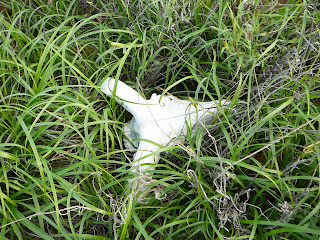On Sunday we decided to big a trip over to the West side of the island. We initially drove to Mystery Beach, a small beach which acts as a trap for all sorts of flotsam and jetsam. Some enterprising person had made a teepee type structure out of wood which had been furnished by sightseers over time. I added a hat and a bottle. Due to the spray from the surf I left my camera in the car so there's no record of this cute art installation.
We then drove to The Block - a flat area bordered by 40 metre cliffs which is often home to die-hard fisherfolk. It's called The Block because of the massive boulders (blocks) strewn around that were dumped on the plateau by a tsunami tens of thousands of years ago.
 |
| A boulder at The Block |
At The Block there's a small building which reminded me of shacks at Garden Island with their propped open windows.
The people camping at The Block copped the full brunt of the storm. Because we were on the East side of DHI and below cliffs we were slightly more protected. We found out that Denham airport had recorded a wind gust of 40 knots during the storm. A gazebo the children were sleeping in at The Block blew away and so they made a corral with vehicles and bunked down in swags (and possibly in the building, too). Added to that they had a vehicle that had had a major mechanical failure so they were trying to source parts to fix it - no mean feat so far from civilisation.
We then drove north to Cape Inscription where Vlamingh left a plate in 1616. It is amazing knowing that people lived and operated the lighthouse in such a remote area - they must have been extraordinarily resilient people. We could see where they captured rainwater on the top of the cliff and then channelled it down to a holding tank near the keepers residence. We also saw a temporary plate installed by some wag!
 |
| Cape Inscription Lighthouse and Keepers Quarters |
I am so glad we were able to experience this area prior to the celebration of 400 years because there have been a few changes since we were in the area.
We then drove east deciding to drive on to the beach at Dampier's Landing and head north to Cape Levillain. Unfortunately the beach was very soft and with our narrow tires, even though we were running on low pressure, we managed to get bogged. Up to the axles. With rain coming. I sat in the car until it was unbogged and we headed back to safety.
Driving south we didn't see anywhere that looked as good as our camping spot. The rain at Cape Levillian eventually set in the for the afternoon, although fortunately it held off until we returned to camp. That night we had curried fish for dinner. Once again there was no dew.
The next day my girlfriend and I walked a couple of km from camp along the existing tracks. It was just beautiful - the silence, the sounds, the scents.
 |
| Looking back towards our camp from the top of the track. |
 |
| Looking north on the eastern side of DHI from the top of the cliffs |
The boys went oystering and we had fresh off the rocks oysters for entree one evening. After another successful fishing expedition we had Panko crumbed fish for dinner.
On the second Tuesday we drove to Quoin Head (not to be confused with Quoin Bluff south) to explore and see if we could see some whales. It was a beautiful sunny day and we were rewarded with upwards of 50 whales swimming by during our time there. Unfortunately I didn't get any photographs of the whales but it was just wonderful seeing so many.
Being on the west coast Quoin Head is bordered by huge cliffs. The spray patterns from the waves hitting the cliffs go right to the top. Because of the rain that had fallen and the spray from the waves there are rock pools on the tops of the cliffs. They were just beautiful - possibly my favorite part of DHI!
 |
| Rock Pools at Quoin Head |
 |
| Western edge cliffs |
 |
| Osprey Nest near Charlies Harbour Lookout |
Our last few days were spent relaxing, fishing for the fishermen and reading. We had all successfully adapted to living with the rhythms of the day, rather than the demands of the clock. I read at least 4 books - bliss! And then all too quickly we were packing up to head home. I said good bye to my beautiful view, which I hope to see again some day.
 |
| View from our living area |
The next morning as the sun rose we drove on the barge and left beautiful, peaceful DHI.
 |
| The sun rising as we leave DHI via the barge |
On the way out we drove to Hamelin Pool and had a look at the stromatolites. We then travelled to Northampton where we stayed at a farm stay. Everyone enjoyed the hot showers on offer! At 2am my hubby and I were both awake listening to the rain on the roof. It stopped for a while so we decided to leave instead of chancing it to not be raining when we got up in the morning. We drove through what turned out to be consistent rain, arriving home about 8am.
As I said this was one of the best holidays I've had for many years. Being completely removed from everyday life and living so close to nature were just blissful.












